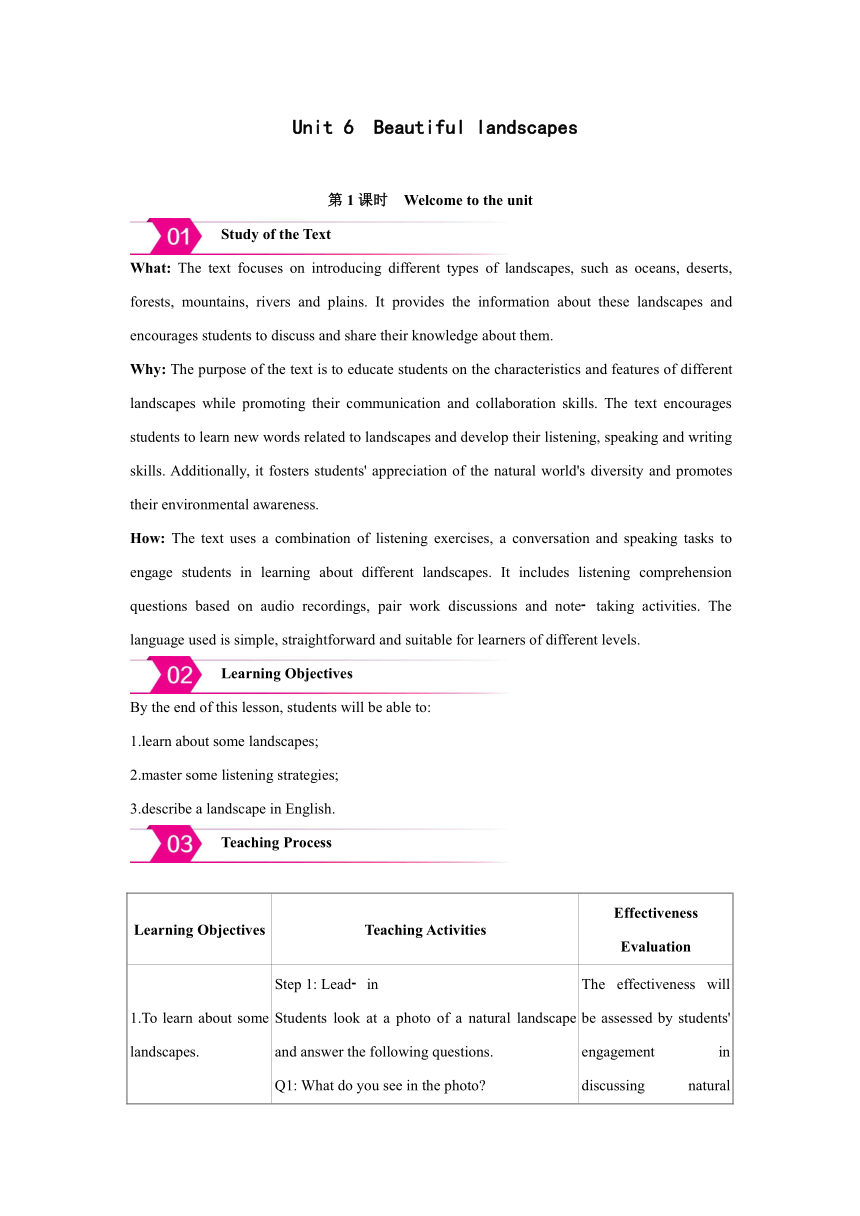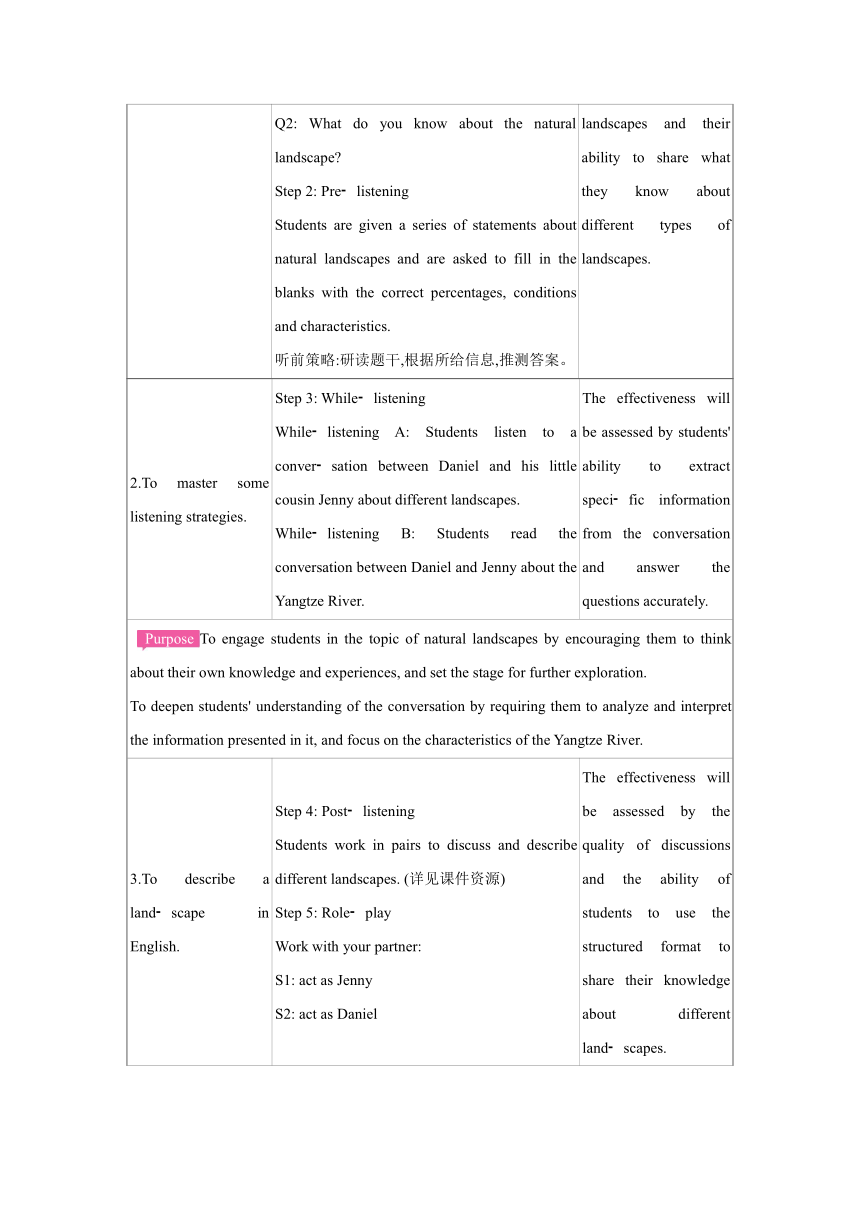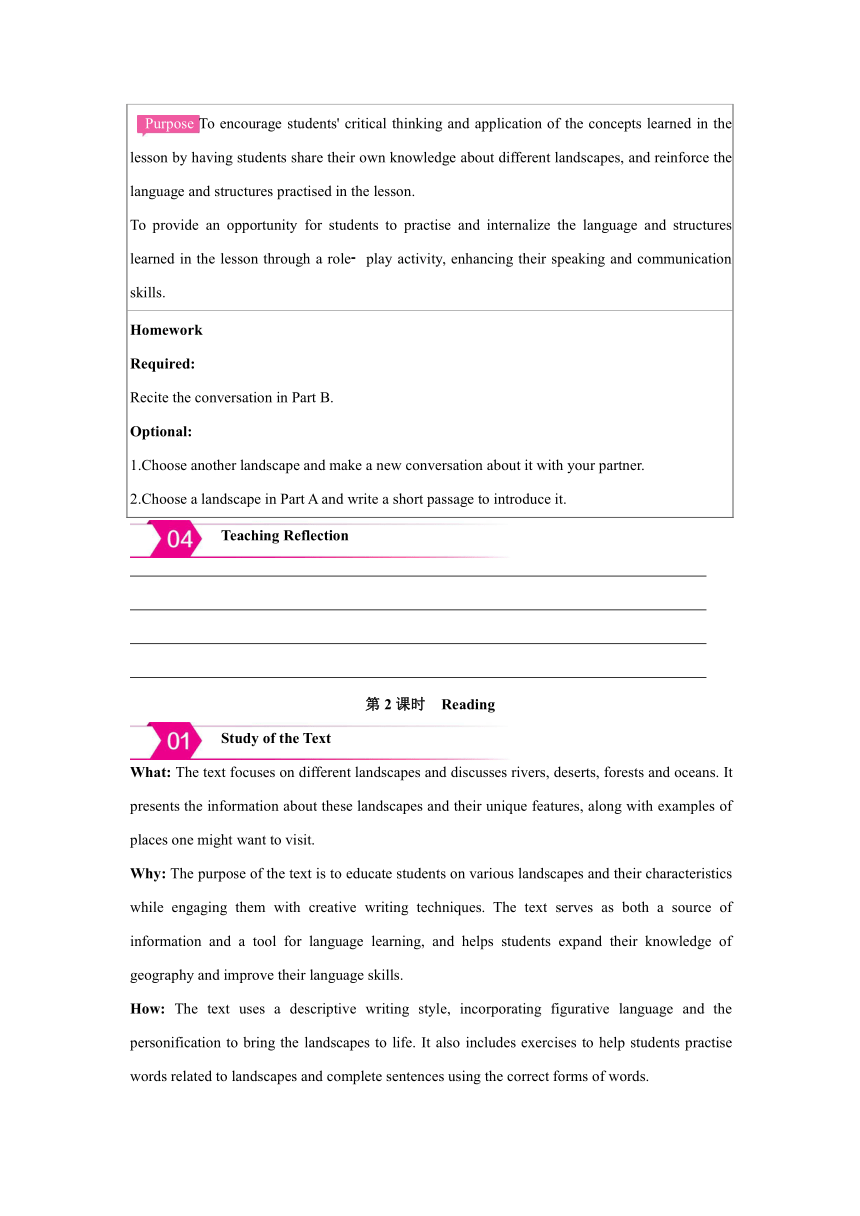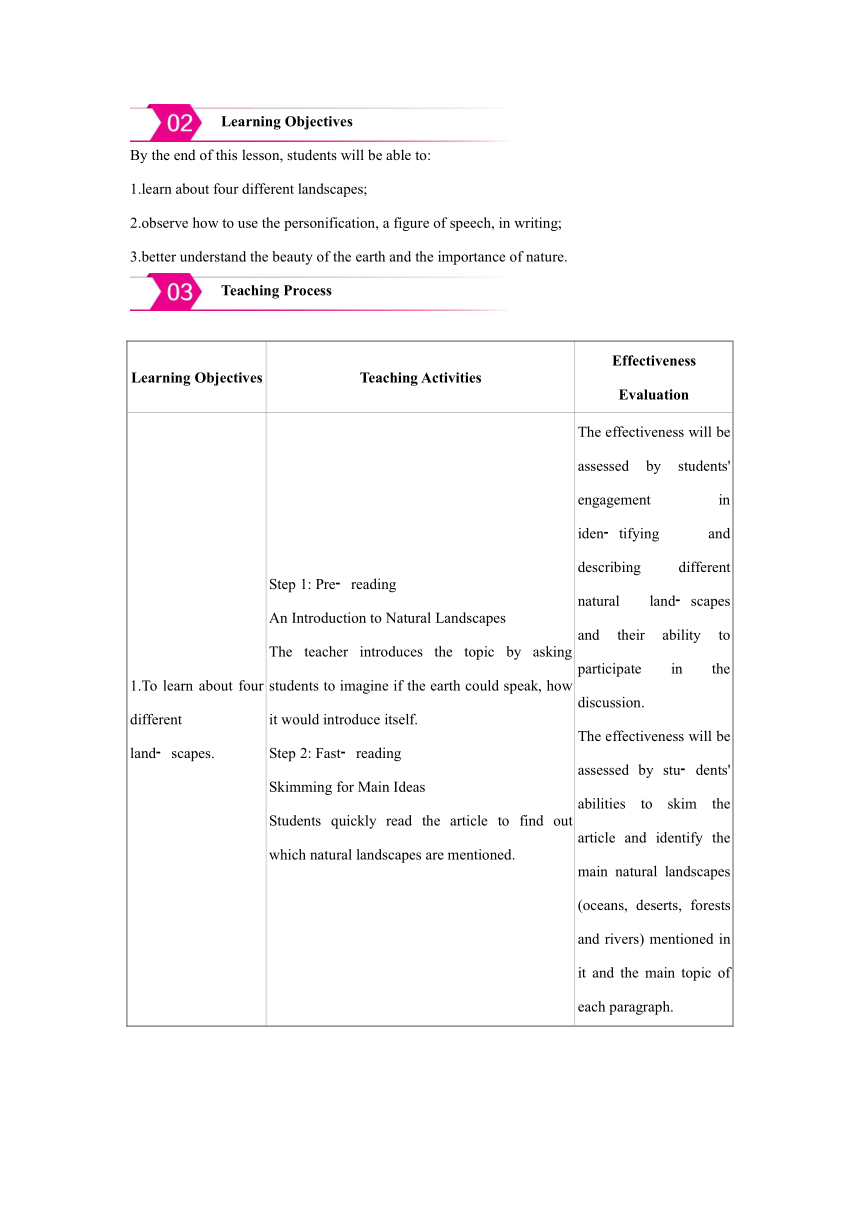 资源简介
资源简介
世界
Unit 6 Beautiful landscapes
第1课时 Welcome to the unit
Study of the Text
What: The text focuses on introducing different types of landscapes, such as oceans, deserts, forests, mountains, rivers and plains. It provides the information about these landscapes and encourages students to discuss and share their knowledge about them.
Why: The purpose of the text is to educate students on the characteristics and features of different landscapes while promoting their communication and collaboration skills. The text encourages students to learn new words related to landscapes and develop their listening, speaking and writing skills. Additionally, it fosters students' appreciation of the natural world's diversity and promotes their environmental awareness.
How: The text uses a combination of listening exercises, a conversation and speaking tasks to engage students in learning about different landscapes. It includes listening comprehension questions based on audio recordings, pair work discussions and note taking activities. The language used is simple, straightforward and suitable for learners of different levels.
Learning Objectives
By the end of this lesson, students will be able to:
1.learn about some landscapes;
2.master some listening strategies;
3.describe a landscape in English.
Teaching Process
Learning Objectives Teaching Activities Effectiveness Evaluation
1.To learn about some landscapes. Step 1: Lead in Students look at a photo of a natural landscape and answer the following questions. Q1: What do you see in the photo Q2: What do you know about the natural landscape Step 2: Pre listening Students are given a series of statements about natural landscapes and are asked to fill in the blanks with the correct percentages, conditions and characteristics. 听前策略:研读题干,根据所给信息,推测答案。 The effectiveness will be assessed by students' engagement in discussing natural landscapes and their ability to share what they know about different types of landscapes.
2.To master some listening strategies. Step 3: While listening While listening A: Students listen to a conver sation between Daniel and his little cousin Jenny about different landscapes. While listening B: Students read the conversation between Daniel and Jenny about the Yangtze River. The effectiveness will be assessed by students' ability to extract speci fic information from the conversation and answer the questions accurately.
Purpose To engage students in the topic of natural landscapes by encouraging them to think about their own knowledge and experiences, and set the stage for further exploration. To deepen students' understanding of the conversation by requiring them to analyze and interpret the information presented in it, and focus on the characteristics of the Yangtze River.
3.To describe a land scape in English. Step 4: Post listening Students work in pairs to discuss and describe different landscapes. (详见课件资源) Step 5: Role play Work with your partner: S1: act as Jenny S2: act as Daniel The effectiveness will be assessed by the quality of discussions and the ability of students to use the structured format to share their knowledge about different land scapes.
Purpose To encourage students' critical thinking and application of the concepts learned in the lesson by having students share their own knowledge about different landscapes, and reinforce the language and structures practised in the lesson. To provide an opportunity for students to practise and internalize the language and structures learned in the lesson through a role play activity, enhancing their speaking and communication skills.
Homework Required: Recite the conversation in Part B. Optional: 1.Choose another landscape and make a new conversation about it with your partner. 2.Choose a landscape in Part A and write a short passage to introduce it.
Teaching Reflection
第2课时 Reading
Study of the Text
What: The text focuses on different landscapes and discusses rivers, deserts, forests and oceans. It presents the information about these landscapes and their unique features, along with examples of places one might want to visit.
Why: The purpose of the text is to educate students on various landscapes and their characteristics while engaging them with creative writing techniques. The text serves as both a source of information and a tool for language learning, and helps students expand their knowledge of geography and improve their language skills.
How: The text uses a descriptive writing style, incorporating figurative language and the personification to bring the landscapes to life. It also includes exercises to help students practise words related to landscapes and complete sentences using the correct forms of words.
Learning Objectives
By the end of this lesson, students will be able to:
1.learn about four different landscapes;
2.observe how to use the personification, a figure of speech, in writing;
3.better understand the beauty of the earth and the importance of nature.
Teaching Process
Learning Objectives Teaching Activities Effectiveness Evaluation
1.To learn about four different land scapes. Step 1: Pre reading An Introduction to Natural Landscapes The teacher introduces the topic by asking students to imagine if the earth could speak, how it would introduce itself. Step 2: Fast reading Skimming for Main Ideas Students quickly read the article to find out which natural landscapes are mentioned. The effectiveness will be assessed by students' engagement in iden tifying and describing different natural land scapes and their ability to participate in the discussion. The effectiveness will be assessed by stu dents' abilities to skim the article and identify the main natural landscapes (oceans, deserts, forests and rivers) mentioned in it and the main topic of each paragraph.
(续表)
Purpose To engage students in the topic of“Natural Landscapes”by encouraging them to think about the earth and its diverse features, and set the stage for further exploration. To give students a quick overview of the content and familiarize them with the key natural landscapes and their characteristics.
2.To observe how to use the personifi cation, a figure of speech, in writing. 3.To better under stand the beauty of the earth and the importance of nature. Step 3: Detailed reading 1.Reading for Details Students read the article in detail to answer specific questions about each landscape. 2.Completing Notes Students complete a set of notes with the information from the article. Step 4: Post reading 1.Discussion and Reflection Students discuss the following questions in pairs or small groups.(详见课件资源) 2.Read Simon's, Amy's and Sandy's articles again and find out their reasons. 3.Writing Practice Students write a short paragraph about a landscape they want to visit, and explain why it is special to them.(详见课件资源) The effectiveness will be assessed by the completeness and accuracy of the notes completed by the students. The effectiveness will be assessed by the coherence and clarity of the paragraphs written by the students, including their ability to use the language and structures learned in the lesson.
Purpose To deepen students' understanding of the article by requiring them to analyze and interpret the information presented in it, and focus on the specific characteristics and roles of each natural landscape. To encourage students' critical thinking and application of the concepts learned in the lesson by having students share their own preferences and reasons for choosing the particular landscape, and reinforce the language and structures practised in the lesson.
Homework Required: Write an article about a place you want to visit, and you should write down the reasons why you choose this place.(within 150 words) Optional: Search more other landscapes on the Internet, and share them with your classmates.
Teaching Reflection
第3课时 Grammar&Pronunciation
Study of the Text
What: The text teaches English grammar, including the use of indefinite pronouns and sentence structures to express strong feelings, and intonation patterns in speech. It provides examples and exercises to help students learn and practise these language components. The materials cover topics, such as camping trips, landscapes and daily interactions, using illustrations and real life scenarios to make the lesson more engaging and relevant to students' lives.
Why: The purpose of the text is to enhance students' understanding of English grammar and pronunciation by providing practical examples and opportunities for practice. The text aims to develop students' ability to express themselves more effectively in English, focusing on the proper use of indefinite pronouns, strong emotions, and intonation patterns in everyday communication.
How: The text uses a combination of reading exercises, conversations and explanations to teach the target language points. It provides examples and situations in which the students can apply the new grammar rules and intonation patterns. The lesson is presented through dialogues and tasks, which involve completing sentences, finding suitable phrases and identifying different types of intonation in communication.
Learning Objectives
By the end of this lesson, students will be able to:
1.recognize and flexibly use indefinite pronouns;
2.understand the sentence structure of exclamatory sentences;
3.distinguish the differences between “how” and “what” in exclamatory sentences;
4.use different types of intonation in various sentences.
Teaching Process
Learning Objectives Teaching Activities Effectiveness Evaluation
1.To recognize and flexibly use inde finite pronouns. Step 1: Grammar(Using indefinite pronouns) 1.Students read some sentences and get a basic impression of the use of indefinite pronouns in context. 2.Students learn indefinite pronouns.(详见课件资源) 3.Work out the rule.(详见课件资源) 4.Students work on identifying and using indefinite pronouns in sentences. 5.Students find a picture of a landscape with people in it and discuss it with their partner, using indefinite pronouns. Students' accuracy of using indefinite pronouns in written exercises and their ability to incorporate these pronouns naturally in discussions will be assessed.
Purpose To introduce and practise indefinite pronouns in various contexts, enhancing students' ability to describe scenes and express uncertain things.
2.To understand the sentence structure of exclamatory sentences. 3.To distinguish the differences be tween “how” and“what”in exclamatory sen tences. Step 2: Grammar(Using“what”and“how”to express strong feelings) 1.Students read a conversation about Huanglong in Sichuan and pay attention to the use of“what”and“how”to express strong feelings. 2.Students learn the structures of exclamatory sentences: “What+a/an+adj.+n.(+主语+谓语)!”“How+adj.(+主语+谓语)!” 3.Work out the rule.(详见课件资源) 4.Students complete a conversation between Mr Wu and Daniel about the Songhua River, using“what”and“how”to express their feelings. Students' understanding of sentence structures and their ability to create original exclamatory sentences that accurately convey strong feelings will be evaluated.
Purpose To teach students how to express strong feelings using“what”and“how”in exclamatory sentences, enhancing their ability to express strong feelings in English.
Step 3: Pronunciation(Intonation) 1.Students read and listen to examples of different types of intonation: falling intonation, rising intonation and fall rise intonation.(详见课件资源)
4.To use different types of intonation in various sentences. 2.Students practise using different types of intonation in various sentence structures. 3.Students practise reading a conversation between Sandy and Millie, paying special attention to the intonation patterns. Students' improvement in using appropriate intonation and their ability to recognize different intonation patterns will be measured through their performance in drills and role plays.
Purpose To improve students' pronunciation skills by focusing on the correct use of intonation in different types of sentences, making their spoken English more natural and expressive.
Step 4: Exercise 1.Students match sentences to the appropriate type of intonation (falling, rising, fall rise). 2.Students complete multiple choice questions to test their understanding of indefinite pronouns and exclamatory sentences. Their ability to apply the learned skills in group discussions and presentations will also be evaluated.
Purpose To reinforce the language points in the lesson through practical exercises, ensuring that students can use indefinite pronouns, exclamatory sentences and appropriate intonation accurately and confidently in various contexts.
Homework Required: 1.Use indefinite pronouns to introduce your room. 2.Write 4 exclamatory sentences using“how”and“what”to introduce China. Optional: Draw a landscape that interests you and introduce it to your classmates in English.
Teaching Reflection
第4课时 Integration (A—C)
Study of the Text
What: The text focuses on Chinese landscapes, featuring some specific locations—the Danxia landform, the Yadan landform, the Stone Forest and so on. It includes the information about each landscape's unique features accompanied by images and a listening activity about visiting Yunnan Province.
Why: The purpose of the text is to introduce China's diverse landscapes to students and encourage them to appreciate the country's natural beauty. By presenting different landscapes and their distinct characteristics, the text fosters students' curiosity and their interest in geography and environmental diversity.
How: The text presents the information through a combination of written descriptions, images, and a listening exercise. It engages students by asking them to describe and compare landscapes based on the provided information and their own research.
Learning Objectives
By the end of this lesson, students will be able to:
1.learn about some interesting landscapes in China;
2.practise reading strategies;
3.talk about interesting landscapes in pairs;
4.better understand the beauty of landscapes in China.
Teaching Process
Learning Objectives Teaching Activities Effectiveness Evaluation
1.To learn about some interesting landscapes in China. 2.To practise reading strategies. Step 1: Lead in Students talk about interesting landscapes in China and answer the following questions. Q1: What landforms are they Q2: What are their features Step 2: Reading 1.Students read the article about the Danxia landform and the Yadan landform and answer the following questions. Q1: What does the Danxia landform in Zhangye look like Q2: What makes the Yadan landform 2.Students read the article again and match the English interpretation with words.(详见课件资源) Step 3: Listening Students listen to a radio advertisement about visiting Yunnan Province, and complete Daniel's notes with the information about the special features of different places in Yunnan. The effectiveness will be assessed by students' comprehension of the text and their ability to accurately answer the questions about the Danxia landform and the Yadan landform. The effectiveness will be assessed by students' ability to listen carefully and fill in the blanks with the correct information about the special features of each place.
(续表)
Purpose To develop students' reading comprehension skills and help them understand the unique features and formation processes of different natural landforms. To improve their listening comprehension skills and introduce students to the unique attractions of Yunnan Province.
3.To talk about interesting land scapes in pairs. 4.To better under stand the beauty of landscapes in China. Step 4: Speaking 1.Students talk about the interesting landscapes they want to see. 2.Students read the conversation between Daniel and Millie. 3.Listen and mark the stressed words and intonation.(详见课件资源) 4.Role play the conversation. Step 5: Pair work Students work in pairs to discuss their travel plans for the year. S1: Where would you like to visit this year S2: I want to go to…in…It looks like… S1: How/What…! S2: What about you S1: I'm interested in…There is/are… S2: Wow, how/what…! The effectiveness will be assessed by students' ability to accurately and confidently perform the role play, including their pronunciation, use of body language, and creative additions to the conversation.
Purpose To provide an opportunity for students to practise and internalize the language and structures learned in the lesson through a role play activity, enhancing their speaking and communication skills. To encourage collaborative learning and speaking practice related to the topic in students, while also reinforcing the language and structures practised in the lesson.
Homework Required: 1.Recite the article in Part A. 2.Make a new conversation with your partner about where you want to visit. Optional: 1.Write a short passage to introduce where you want to visit. 2.Search on the Internet for other landforms in China.
Teaching Reflection
第5课时 Integration (D)
Study of the Text
What: The text focuses on describing and writing about beautiful landscapes in China, specifically focusing on Huangshan. It provides guidelines on creating an article about a chosen landscape and offers useful expressions for structuring the description.
Why: The purpose of the text is to develop students' descriptive writing skills and promote their appreciation of China's natural beauty. By providing a model article and useful expressions, the text aims to inspire students' creativity and enhance their ability to convey the uniqueness and appeal of different landscapes. The text emphasizes the importance of vivid language and organization in effectively communicating the charm of a place, fostering a sense of pride in China's natural wonders and encouraging students to explore and learn more about their country's landscapes.
How: The text uses a structured approach to guide students in writing about a landscape, offering tips on how to create a catchy title, give general information, and explain what one can do at the location. It also includes a model article about Huangshan and a list of useful expressions to assist in writing their own articles.
Learning Objectives
By the end of this lesson, students will be able to:
1.read Daniel's article and complete the table with the information about the landscape they choose;
2.write a composition about a beautiful or an interesting landscape in China by using the words and sentence patterns they have learned;
3.raise the awareness of protecting landscapes.
Teaching Process
Learning Objectives Teaching Activities Effectiveness Evaluation
1.To read Daniel's article and complete the table with the information about the landscape they choose. Step 1: Lead in Students discuss beautiful or interesting landscapes in China. Step 2: Reading 1.Students read Daniel's article about Huangshan, focusing on its name, location, and what it is famous for. 2.Read Daniel's article about an interesting landscape and complete the table. The effectiveness will be assessed by stu dents' engagement in the discussion and their ability to share personal opinions and experiences related to landscapes in China. The effectiveness will be assessed by students' comprehension of Daniel's article and their accuracy in completing the table and answering the questions.
(续表)
Purpose To activate students' prior knowledge and personal experiences, setting the stage for the reading activity by engaging them in the topic of“Landscapes”. To improve reading comprehension skills and understand how to describe a landscape in detail, including its location, features, and what people can do or see in the place.
2.To write a compos ition about a beautiful or an interesting land scape in China by using the words and sentence patterns they have learned. 3.To raise the awareness of pro tecting landscapes. Step 3: Analyzing 1.Students analyze the structure of the article. (详见课件资源) 2.Students learn about the structure of Daniel's article, including the title, beginning(name and location), body (special or interesting things, what you can do or see in it) and ending. Step 4: Writing 1.Students are given the prompt to write about the Great Wall, using the structure and tips learned from the previous steps. 2.Students write an article about a beautiful or an interesting landscape in China based on the information in Part D1.Use Daniel's article as a model. The effectiveness will be assessed by students' ability to identify and understand the structure of the article and their ability to think critically about what to include in each section. The effectiveness will be assessed by students' ability to write a coherent passage about the Great Wall, using the model passage and provided structure.
Purpose To help students understand the structure of a descriptive article and learn how to organize information effectively. To apply the knowledge gained from the reading and discussion to create a detailed written piece about a famous Chinese landmark, ensuring that students can effectively describe a landscape and its features.
Homework Required: Complete your passage. Optional: Find out more about places of interest in China online.
Teaching Reflection
展开更多......
收起↑
 资源预览
资源预览





 资源预览
资源预览




